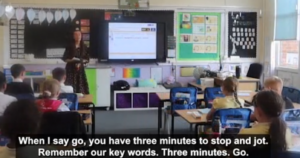07.23.24Using Writing in The (Reading) Classroom–The Amazing Success of First Year Teacher Emily Fleming

Great task; great directions; great results
Last week I had the pleasure of joining Kristen McQuillan, Natalie Wexler and Julia Cooper on a webinar sponsored by the Knowledge Matters campaign. Topic: The critical role of writing in reading comprehension.
You can watch the webinar here: https://knowledgematterscampaign.org/post/writing-an-unsung-hero-of-reading-comprehension/
Meanwhile I thought I’d share a lovely video of a teacher using writing in really dynamic and effective ways in the classroom. And as if that’s not exciting enough the video is of a teacher completing her very first year in the classroom! It’s definitely inspiring.
The teacher is Emily Fleming who teaches year 4 (5th grade for us) at Goldsmith’s Primary Academy in Walsall, England. FWIW the school has some of the highest levels of economic deprivation in England among it’s students.
The first thing you might observe is when Emily’s students write: In the midst of reading. Her writing is, as I discussed on the webinar, frequent and formative. Her students write multiple times, in the midst of reading and thinking about text, with the purpose of discovery. Formative writing is, to my team, writing where students use the experience to discover what they think more clearly, rather than to explain or justify what they already know.
Another key aspect of the writing here is that it comes before student discussion. This has a powerful effect on the discussion that comes after. Students are eager to participate and have lots to say because they have all had time to think deeply about the question. Writing about it is more effortful than just talking about it… this creates desirable difficulty which facilitates learning and memory. But it also incentivizes and democratizes participation in the discussion that comes after. You can see how it effects students in watching their reaction to the turn and talk. It literally crackles to life.
Notice also how brilliantly Emily’s students are able to talk to instead of past one another. They constantly make reference to previous speakers and build off of their ideas. One reason they do this so well is that Emily has installed Habits of Discussion. She has taught them how to make a comment that connects to those of previous speakers. But another reason is because they have all written their ideas down. Now their working memory is free to actually listen rather than to sit and rehearse, while a classmate is talking, what they wanted to say so they don’t forget it. If we want students to listen, letting them write down their ideas frees their working memory to do this.
Next you’ll notice that while students are discussing, Emily is tracking the conversation in a discussion box. This discussion box is both on the front board and on their tablets. They are mirror images of each other. So Emily is modeling the sort of note-taking she wants her pupils to do.
But she’s also tracking the key ideas from the discussion because she wants her students to do more than just have a lovely and mutually supportive conversation. She wants them to use the discussion to generate ideas to revise and improve their writing.
One of the biggest benefits of shorter writing prompts is that we can have students revise and improve them right away-either incorporating new ideas from peers, as Emily does here, or based on feedback, much as Emily’s colleague at Goldsmith’s, Scott Wells does here:
Write. Study. Point out ways to get better. Rewrite and apply.
It’s pretty amazing stuff.
One last point. One thing that surely explains Emily’s incredible success as a first year teacher is how good she is at something we call the What To Do Cycle: Give a clear and observable direction. Scan to see whether students do it and let them see you scanning so they know it matters. Positively reinforce to let students know you see and care when they do the right thing. Correct as necessary- and as non-invasively as possible.
Again and again Emily does this with aplomb, as in, “When I say go, you have three minutes to stop and jot. Remember our key words. Three minutes. Go!”
In addition to all the other ways having this level of happy productiveness among students makes her classroom better, it means that when she sends them off to write, everyone’s pencil is moving within seconds. When she asks them to be writing everyone–every single kid–is writing. Almost right away.
So: some great examples of how to sue writing in the classroom, especially to support reading and a really inspiring portrait of a first year teach on the road to success!

One Response to “Using Writing in The (Reading) Classroom–The Amazing Success of First Year Teacher Emily Fleming”